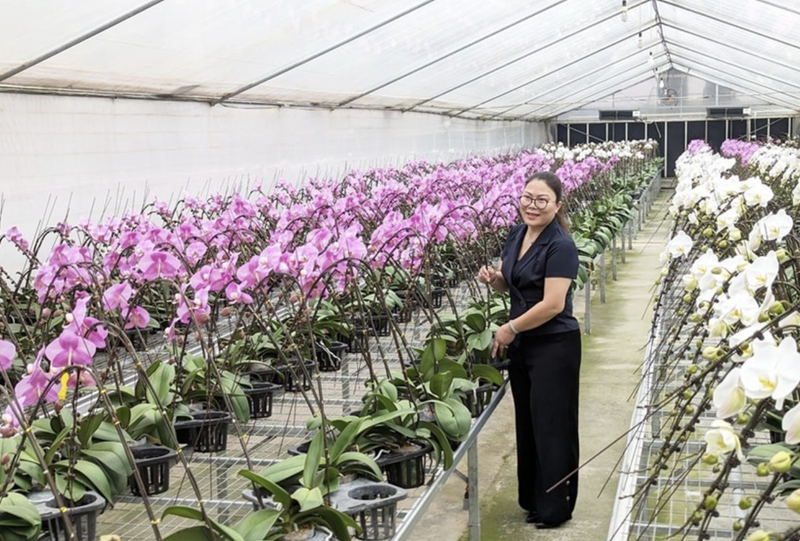Effective models emerging
According to the Hanoi Agricultural Extension Center under the Municipal Department of Agriculture and Environment, the city currently has more than 3,000 ha of flower-growing areas, including about 47 large-scale flower production zones covering over 1,800 ha in districts such as Tay Ho, Me Linh, Dan Phuong, Thuong Tin, and Gia Lam. High-quality flower cultivation accounts for over 30% of the total area, with several varieties such as orchids, lilies, and chrysanthemums already being exported.
    |
 |
|
The high-tech orchid cultivation model of Dan Hoai Cooperative generates considerable economic value. (Photo: hanoimoi.vn) |
Many high-tech flower farms have adopted automated irrigation systems, light and temperature regulation, and have achieved relatively high productivity. The average production value ranges from 500 million (18,900 USD) to 1.5 billion VND (56,9000 USD) per hectare per year, with some models earning up to 2.2 billion VND per hectare annually.
The use of smart management systems, greenhouse and net house technologies, and water-saving irrigation helps farmers actively manage production, enhance competitiveness, and meet strict market demands, thereby increasing profits compared with traditional flower cultivation.
Ngo Minh Truong from My Hung commune said his family has developed a 2,500-sqm orchid garden applying hi-tech methods since 2019, now growing nearly 80,000 orchid pots of 30 - 40 colorful varieties. Hi-tech flower cultivation not only brings higher economic efficiency but also produces high-quality, diverse, and stable products. This helps farmers compete better domestically and internationally while reducing chemical use and optimizing resources, contributing to environmental and public health protection, he said.
Developing farm-based models linked with tourism
Despite positive results, hi-tech flower production still faces challenges due to high investment costs, production risks, small-scale operations, and limited branding among cooperatives and enterprises, making it difficult to expand market reach.
To replicate and expand hi-tech flower cultivation suitable to Hanoi’s soil conditions, Nguyen Thi Thuy, owner of Me Linh F-Farm, suggested that the city continue offering preferential credit policies to help businesses and cooperatives invest in infrastructure, greenhouses, and production facilities. She also emphasized the need for science and technology transfer, as well as support for building local flower brands and labels to boost consumption.
Nguyen Manh Phuong, the Deputy Director of the Hanoi Department of Agriculture and Environment, stated that in the near future, the department will enhance collaboration with local communities to offer training on greenhouse flower cultivation techniques aimed at achieving high productivity and economic efficiency.
The department will also guide farmers on disaster prevention and climate change adaptation. Additionally, there will be a gradual transition from low-yield rice cultivation to flower farming, especially in riverbank areas. This initiative will also promote flower farming in connection with experiential tourism.
The department will collaborate with relevant units within the Ministry of Agriculture and Environment to enhance research and breeding of new flower varieties that are suitable for the local climate, soil conditions, and consumer preferences. Local authorities will partner with industry associations to build brands, establish planting codes, and create digital maps for ornamental plants.
These efforts are expected to increase product value per unit area, create jobs, improve farmers’ incomes, promote exports, and drive agricultural restructuring, while beautifying the landscape and protecting the environment.
Source: VNA